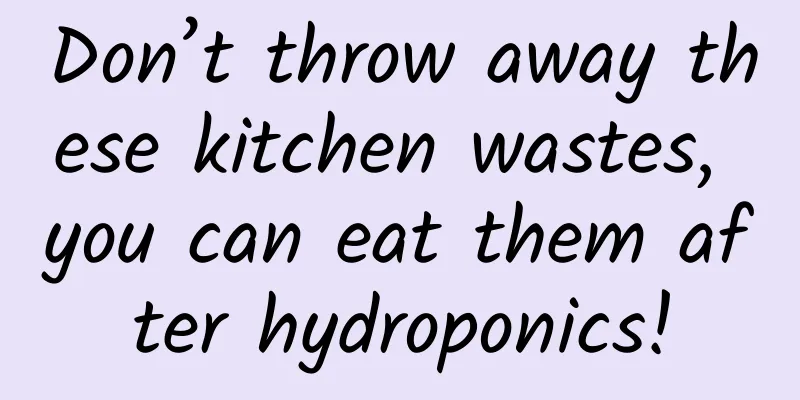Don’t throw away these kitchen wastes, you can eat them after hydroponics!

|
In the past two months, how to stock up on vegetables has become a major concern for many people, especially green vegetables. If you stock up too much, you may worry that the leaves will rot, but if you stock up too little, you may worry that there will not be enough to eat in an emergency. Many friends have set their sights on growing vegetables on the balcony, but they are troubled by the lack of soil and seeds, or the lack of space at home. At this time, hydroponics may become a new option. We have compiled some simple hydroponic vegetable growing methods. Although it is impossible to achieve vegetable freedom completely through hydroponics, at least you can eat the vegetables of this meal and let them grow the next meal. Even if it is not during the epidemic, these methods are also fun and make the best use of planting activities. Calendar girl's colleague hydroponically grows Shanghai green|Rain knocking on the window Peanuts Most families who cook will stock up on raw peanuts, melon seeds, beans, etc. These grains are essentially seeds. Therefore, as long as they are whole beans or peanuts - raw, with seed coats, and look intact and healthy, they can probably be used for germination! Sunflower seed sprouts | naturenow/wikipedia A quick note: Don’t use the peeled bean paste below for making mung bean paste! If it is soaked and rotten, it may not grow anything and may even grow mold. Peeled mung bean | Taobao product details No matter what method is used to sprout bean, the principle is the same: water-oxygen balance. When beans and peanuts are used as food, they need to be stored for a long time, so the seeds lose a lot of water and are in a relatively dry environment. Therefore, the first step in sprouting bean must be to soak the seeds in advance so that the seeds can fully absorb water and meet the prerequisites for rapid germination. If you want to effectively provide a good germination environment for seeds, the simplest tools are gauze, a basket and a vegetable washing basket. This basic method is suitable for all kinds of beans, peanuts, and all sprouts! Simple bean sprout props, of course there are other DIY tools, I won't list them all here, you can give full play to your imagination in life|fine art of cooking/youtube Steps for growing bean sprouts 1. Pick out the bad beans! (To prevent rot and hair growth) 2. Soak the seeds in water at room temperature for about 8 hours; 3. Prepare clean instruments and wet clean gauze and wring it slightly dry; 4. Spread the soaked beans on gauze and cover with a dry cloth to avoid light; 5. Water 2 to 5 times a day, and drain the excess water. Continue to grow away from light. The beans will slowly sprout, and new growth can be seen every day. 6. The growth period is related to the environment. It takes about 5 days to reach the length of bean sprouts purchased in the market. New sprouts between 1 and 10 cm can be eaten! 7. When collecting, pay attention to whether there is any different color or odor on the surface; and, be sure to rinse it thoroughly before putting it into the pot! If you want to make your sprouting work look more professional, you can also choose a special sprout basket that does not require electricity, or a bean sprout machine that needs to be plugged in. For these two types, please refer to the product manual directly. Different product designs will have different methods, but their principles are still the same. Special bean sprout basket | amazon Bean sprout machine | amazon Since they have sprouted, can we eat them if they grow a little longer? No problem! On the third day, you can get green sprouts by turning them into dark-proof mode! But if you want them to grow, it is best to enter the next stage early - around the third day, select a few strong ones, transplant them into the substrate or soil, and continue to cultivate them. Hydroponic sprouts are easy to operate and suitable for beginners, but there are still a few precautions. The most important thing is to keep the sprouting equipment clean - once it is contaminated with certain molds, it may not be killed even at high temperatures. Therefore, be sure to carefully scrub the equipment before hydroponics, which can greatly reduce the risk of mold contamination. In addition, the sprouts you grow yourself must be rinsed several times before eating to prevent contamination by microorganisms that are invisible to the naked eye. If you want to grow some other small sprouts, there is a useful small bottle recommended to everyone - the sprouting jar. This jar is actually a glass jar with a mesh lid - there are two types of metal and plastic, and it can also be replaced with gauze. It is suitable for growing bean sprouts, and it is also suitable for growing various sprouts with smaller seeds, such as broccoli, carrots and purple cabbage. The sprouting jar and seeds can be found on Taobao, and the sprouts grown are suitable for making various light meals. Sprout tank: The sprouts that can be grown include (left) alfalfa sprouts, bean sprouts, radish sprouts, (right) beet sprouts, pea sprouts, sunflower sprouts | spruce Kitchen Waste In addition to beans, many green leafy vegetables can also be grown hydroponically. Especially the roots of vegetables, which we regard as kitchen waste, don't throw them away. Put them in water and they can grow leaves again! 1 Seasoning: Onion and garlic Various types of onions and garlic can be said to be the best friends of hydroponic novices. They can grow just by throwing them in, which is very face-saving. Regardless of whether it is for daily use or during quarantine, try to buy onions with roots. After returning, either soak them in water or plant them in pots or fields. Cut some leaves whenever you need them. From now on, eating onions freely is no longer a dream! Of course, this is just for seasoning. If you eat them with dipping sauces in Shandong and Northeast China, this amount of hydroponics is really not enough. Green onions hydroponically grown (left) just after planting, (middle) 5th day, (right) 11th day|살구/ youtube 2 Various vegetables: Shanghai greens, lettuce, celery Shanghai greens, lettuce and celery are the most common vegetables received by friends at home. All three are very suitable for hydroponics - eat the big leaves and leave the small hearts for planting. When growing hydroponically, you can insert a few toothpicks to leave the bottom of the cabbage hanging in the air to prevent the part you want to eat from drowning and rotting. If you have a pot and soil at home, it is better to plant it directly in the soil. Their growth rate is related to the climate in different regions, but I believe that the growth of this cabbage will definitely not disappoint you! Green cabbage heart hydroponics, 7 days of growth|Jazzy Gray-Sadler / youtube Romaine lettuce hydroponics (left) just planted, (middle) 5 days old, (right) 11 days old|Jennifer Stavropoulos / youtube 3 Vegetable stems: Chrysanthemum chrysanthemum, Auricularia auricula As hollyhock and chrysanthemum are easily damaged and not durable in storage, they are hardly the first choice for stockpiling vegetables. But in fact, as long as the stems that are discarded as kitchen waste during daily cooking are preserved, they can be used for planting. The stems used for cultivation need to be longer than the parts that are usually removed when picking vegetables, and 2 to 3 stem nodes (stem nodes are where leaves grow) must be retained. Then, just stick the stems in water, and they will take root and grow leaves. In comparison, it is not cost-effective to grow chrysanthemums for eating only the leaves, and it is more economical to grow wood ear vegetables. If you are lucky enough to buy a plant with roots, you can eat the leaves earlier! The edible fungus (left) has been growing for several days, and (middle right) is newly planted|SABITA'S CREATIVITY AND LIFESTYLE / youtube Chrysanthemum chrysanthemum sprouts|Khang Starr / youtube 4 Roots: sweet potatoes, carrots, radishes Many people have seen sprouting sweet potatoes. As long as you keep them, grow them hydroponically or bury them directly in the soil, they will continue to grow. The leaves that grow can also be used to blanch vegetables and cook noodles. But can the leaves of carrots and radishes be eaten? Yes! Usually when cooking, the top part of the roots of radishes and carrots is thrown away. If you leave this part (of course, leave more than usual), find a container and add some clean water, the radish will grow. Remember to change the water every day, otherwise the radish will stink. The leaves grown from radishes and carrots can be eaten with sauces, and can also be used as sauces👇 Sauce made from carrot leaves | Elise Bauer / simplyrecipes.com Carrot Experiment | redkitedays.co.uk As for some vegetables, we should not expect them to "refill" and just eat them. For example, peppers, green peppers, eggplants and tomatoes, it is okay to plant them in the soil, but they need to take root, sprout, grow leaves and bear fruit, and it may take several months before they can be eaten. If potatoes have turned green and have obviously grown thick branches, don't eat them! You can leave them and wait for them to bloom, but don't eat them, be careful of alkaloid poisoning. Potatoes are beautiful when they bloom, and the most common ones are light purple ones|AL-Travelpicture / gardeningknowhow.com The above methods are slightly different in operation, but the best environment is to choose a location on the balcony that can receive scattered light. In terms of nutrition, plants that only eat leaves do not need special nutrient solution or other fertilizer support. However, if you want to grow large green peppers, eggplants, tomatoes, etc., it is easier to choose substrate cultivation! During the growth process, you need to add some fertilizer in time. Tomatoes grown in balcony substrate | tomatoes / farmer-online There is another type that everyone will be interested in - mushroom bags. As long as you water them regularly, you can harvest fresh mushrooms in 7 to 10 days, and they can continue to grow if handled properly. But they often cannot be stored, and coupled with the time it takes to transport them on the road, usually when you buy them home, each mushroom fruiting body is about to burst. If you want to store a few and take them out when you need them, it is basically impossible. Oyster mushrooms growing out of their bags|Swampy Appleseed / instagram Vegetable freedom is not possible But make the best use of it Whether it is hydroponics or soil culture, the roots of the vegetables we eat daily rely on water and oxygen to survive in non-extreme climates. Therefore, the key to hydroponics and soil culture is to meet the needs of the root system to breathe, absorb water and nutrients. Whether it is sprouting bean sprouts or planting green leafy vegetables, whether you DIY or buy professional equipment, most edible plants need to keep the roots moist and oxygenated. Light can only determine growth, roots determine life and death, and the degree of satisfaction of the plant with the growing environment determines how much you can eat in the end. In a hydroponic environment, roots also need to obtain water, nutrients and oxygen at the same time|Dinkar Gaikwad / Hydroponics Cultivation of Crops, picture translated by monica Based on the above principles, companies have also developed a variety of equipment to help people grow vegetables in minutes. Many planting kits have everything from machines, substrates to seeds, and even watering. However, if we want to harvest delicious vegetables, we still need to spend some time, which is the fun of gardening. "to sprout" vegetable growing machine set: includes seeds, machine and cultivation supplies|lgnewsroom.com How much can we harvest if we use hydroponic vegetable cultivation method? Generally speaking, it takes about 5 days for beans and peanuts to sprout and grow to a length that can be eaten; it takes about 7 to 10 days for the hearts of Shanghai greens, celery, lettuce, etc. to grow to a length that can be eaten. It shouldn't be a problem to soak one portion of beans and plant one portion of greens, and harvest two meals a week. Of course, how much you can harvest in the end depends mainly on how much you plant. After all, many people may not have that much extra space at home, nor may they have enough containers. Therefore, it is probably difficult to meet the daily intake of all green vegetables through hydroponics. However, these methods can maximize the benefits of what we have. Friends who are interested can also make vegetable planting a daily routine rather than an emergency measure, and always have some substrate soil and seeds at home. If you use your imagination, you can also build a farm with a window. Window Farm in a Small Apartment|Julia Makarova / windowfarms After all, taking care of plants and watching them grow over time, these things that have something to do with the countryside can often make us feel a little relaxed and happy in our busy urban lives - at least, when you are isolated at home alone, you can still talk to the plants. Author: monica Editor: Mai Mai This article comes from the Species Calendar, welcome to forward If you need to reprint, please contact [email protected] |
<<: Don't eat it! It has 3,000 to 6,000 parasites in its body.
Recommend
Why is there weightlessness in the space station? Does weightlessness mean “losing weight”?
The astronauts' space lectures let us see man...
China's Sky Eye is amazing! The "identity card" of repeated fast radio bursts has been found
◎ Science and Technology Daily reporter Lu Chengk...
High school mathematics compulsory courses 1, 2, 3, 4, and 5 complete video set, high school mathematics elective complete video set
High School Course Training Course Video Lecture ...
Sky, a new Android development language, will replace Java and stop lag
[[133317]] As the smartphone operating system wit...
9 super useful tips for iOS development
1. How to quickly check the execution time of a p...
While you are still struggling with channels and buying traffic, others have already "swept" users through social platforms
Perhaps in the near future, channels and buying t...
How to use scientific “user segmentation” to break through the bottleneck of user growth?
When talking about the user growth of Internet pr...
Interpreting WeChat paid reading: Is content payment reliable, and how can we follow the trend?
This article starts with the paid reading service...
Summary of essential tools for new media operations and promotion! (superior)
If you want to do your work well, you must first ...
How can products be promoted effectively?
Many people write brilliant copy and make beautif...
NFT marketing, the beginning of the brand metaverse?
If a brand wants to explore the metaverse , the m...
Xiangcheng SEO Training: What does Internet marketing mean to customers? Does online promotion require SEO?
For experienced salespeople, many things are rout...
1 billion views in 100 languages in 31 years, how does content giant TED operate?
TED, a non-profit organization founded in 1984, i...
Another asteroid is about to hit the Earth? The truth...
gossip "An asteroid will hit the earth in se...









